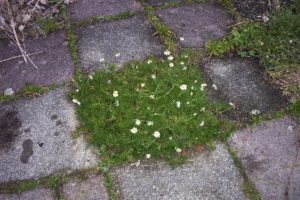 Are you looking for a nice groundcover? A substitute for a grass lawn? Let me suggest Roman chamomile (Chamaemelum nobile). It’s not from Rome as its name suggests. Instead it was given that name by a German botanist who was visiting Rome and saw it there. It has also been called English chamomile because it has so often been used in England for lawns and between pavers.
Are you looking for a nice groundcover? A substitute for a grass lawn? Let me suggest Roman chamomile (Chamaemelum nobile). It’s not from Rome as its name suggests. Instead it was given that name by a German botanist who was visiting Rome and saw it there. It has also been called English chamomile because it has so often been used in England for lawns and between pavers.
Roman chamomile flowers have the same taste and same soothing effects as German chamomile flowers but the plants look very different. German chamomile is a tall annual plant. Roman chamomile is a shorter perennial plant that sprawls rather than growing upright. Both plants are related to ragweed so if you are allergic to ragweed, you shouldn’t drink chamomile tea made from either kind of chamomile.
Native to Western Europe through Northern Ireland, Roman chamomile is hardy in zones 4 through 9. It prefers full sun but will tolerate some shade. The plants themselves grow 3 to 6 inches in height. The flowers, which appear in June and last through September, grow on stalks that are 8 inches tall. You can mow the plants but that will mean sacrificing the flowers which add a nice touch of color to your lawn or path. Plus you can make tea from them.
If you are going to use Roman chamomile as a lawn or on a path, use it in a lightly travelled area. It will not stand up to heavy traffic like grass can. It is also useful as an edging or in a rock garden.
You can grow Roman chamomile from seeds, cuttings or divisions. Unless you mow the flowers, it will readily self-seed itself in your garden although it doesn’t reproduce as prolifically as German chamomile. You can direct sow the seed in your garden after your last frost. Surface sow the seed. Do not not cover. They need light to germinate. Keep the bed evenly moist. Seedlings should be planted 6 to 12 inches apart. This will allow the plants space to sprawl. Maximum sprawl is 12 inches.
After the first flush of flowers, it’s a good idea to cut them back, rather than allowing them to go to seed. The plants will continue growing and will produce a second flush of flowers. The foliage will die back completely in the fall. It should be removed from the garden and composted.

